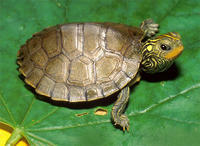NORTHERN MAP TURTLE

This turtle has a short tail, ridged upper and lower shell, rear edge of upper shell is jagged and a small yellow spot behind each eye. The upper shell is gray with lines and circles. The lower shell is gray with darker center lines. The head, limbs and tail are olive or brownish with yellow stripes. The shell length is a maximum of 10 inches.
This species’ habitat includes creeks, rivers, oxbows and lakes with abundant basking sites, slow to moderate current and soft substrate with aquatic vegetation and tree-lined banks. The range has been reduced to smaller creeks in eastern Kansas south of the Kansas River and east of the Flint Hills.

The Common Map Turtle is protected by the Kansas Nongame and Endangered Species Conservation Act and administrative regulations applicable thereto. Any time an eligible project is proposed that will impact the species’ preferred habitats within its probable range, the project sponsor must contact the Ecological Services Section, Kansas Department of Wildlife, Parks and Tourism, 512 SE 25th Ave., Pratt, Kansas 67124-8174. Department personnel can then advise the project sponsor on permit requirements.
DESIGNATED CRITICAL HABITATSAs defined by Kansas Administrative Regulations, critical habitats include those areas documented as currently supporting self-sustaining population(s) of any threatened or endangered species of wildlife as well as those areas determined by the Kansas Department of Wildlife, Parks and Tourism to be essential for the conservation of any threatened or endangered species of wildlife.
Currently, the following areas are designated critical for Common Map Turtles:
(1) The main stem of the Marmaton River from Moran, Allen County (Sec. 36-T24S-R20E) to the Kansas/Missouri border in Bourbon County (Sec. 24-T25S-R25E).
(2) The main stem of Cedar Creek in Anderson County from its point of entry into Sec. 1-T22S-R18E to its confluence with Pottawatomie Creek (Sec. 1-T20S-R19E).
(3) The main stem of the South Fork of Pottawatomie Creek in Anderson County from its point of entry into Sec. 27-T21S-R20E to the confluence with Pottawatomie Creek (Sec. 24- T19S-R20E).
(4) The main stem of the West Fork of Tauy Creek in Franklin County from the Douglas/Franklin County border (Sec. 23-T15S-R19E) to the confluence with Ottawa Creek (Sec. 28-T16S-R20E).
(5) The main stem of Ottawa Creek in Franklin County from the confluence of the West Fork of Tauy Creek (Sec. 23-T15S-R19E) to the confluence with the Marais des Cygnes River (Sec. 11-T17S-R20E).
(6) The main stem of Long Creek in Osage County from the Osage/Coffey County border (Sec. 36-T18S-R15E) to the confluence of the Marais des Cygnes River (Sec. 2-T18S-R16E).
(7) The main stem of Frog Creek in Osage County from the Osage/Coffey County border (Sec. 34-T18S-R15E) to the confluence with Long Creek (Sec. 30-T18S-R16E).
(8) The main stem of the Little Osage River in Bourbon County from the Bourbon/Allen County border (Sec. 36-T23S-R21E) to the Kansas/Missouri border (Sec. 1-T24S-R25E).
(9) The main stem of Appanoose Creek in Franklin County from the Osage/Franklin border (Sec. 23-T15S-R17E) to the confluence with the Marais des Cygnes River (Sec. 32-T16S-R19E).







